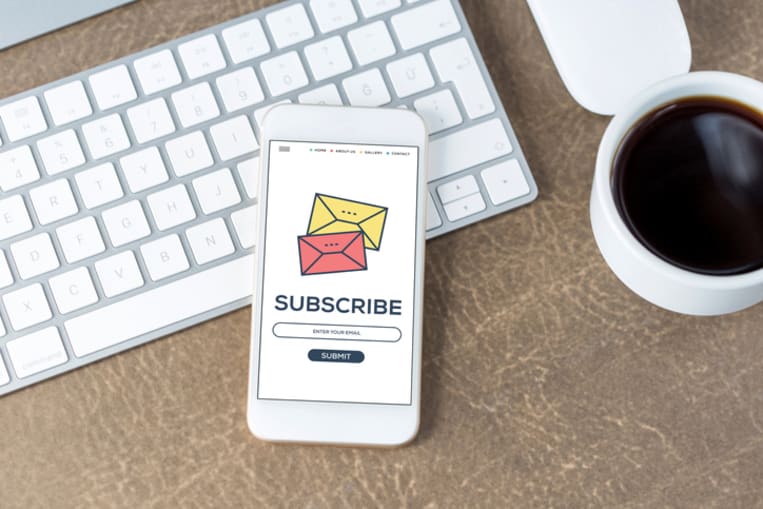
BBB Business Tip: 12 dos and don'ts of email marketing

Smart phone with email subscribe option (Getty Images)
Small business owners need to do more with less and, unfortunately, those limitations often apply to marketing. Because of their efficiency, email marketing campaigns are an option many small businesses turn to for connecting with their customers while staying within a tight budget.
For those unfamiliar, email marketing campaigns consist of a business or service provider sending emails to their client base that encourage action or promote engagement in a way that generates sales or, at the very least, leads to new potential customers.
When performed successfully, recipients of your email take the desired action and interact with your online presence. Your business is placed in front of customers’ eyes, and that leads to future sales or recommendations.
Where to start on the way to pressing send.
Nobody starts out thinking their email marketing campaign is going to fail. The truth of the matter, though, is that it's not as simple as sending an email to thousands of people. There are steps you must take in order to ensure your emails achieve their intended outcome. With this in mind, here is a list of the 12 most important dos and don'ts of a successful email marketing campaign.
1. DO determine who will be on the receiving end of your campaign.
Before you get started on an email marketing campaign, you need to determine who you want to reach. To this end, you will need to build an email list that includes people who are interested in your products or services. And how do you get their email addresses? The solution is simple: invite them to subscribe on your website, either by using a subscribe button throughout your site or with an exit-intent popup that will give them the option prior to leaving a webpage.
2. DO set goals for yourself and your campaign.
One of your first priorities when looking to run a successful email marketing campaign is to set goals. Ask yourself what you want to achieve and how you plan on doing it. Some of the most common goals for an email marketing campaign are the following:
- Attracting new subscribers – You can do this by letting them know about your business and the value you offer, which will then lead to building a relationship with them.
- Increasing engagement – Regardless of whether you want to make a sale or promote any services you offer, this goal focuses on your viewers interacting with the content of your website, which includes any information on your business.
- Providing value to existing customers and subscribers – What is it you would like to offer to your loyal customers? Whatever it is, let them know!
- Bringing inactive subscribers back into the fold – Have you noticed a decrease in traffic to your website? Let your inactive subscribers know what you've been up to and tell them about any new services or products you have to offer.
3. DO decide what kind of email you want to send.
Nail down the purpose behind your campaign. Are you looking to promote your business, offer new services, or showcase special sales? Do you want to send a newsletter or provide your subscribers with the most recent information about your business? Or maybe you simply want to welcome new subscribers or let them know their purchase is on its way. The importance of knowing what type of email you want to send is that it will help you use appropriate wording in the body of the email. This is, in essence, what will attract new customers and drive sales.
4. DO use technology to your advantage.
One of the best ways of creating a successful email marketing campaign is to use available technological tools to your advantage. These tools include analytics, software integration, automation, templates, and workflows (among others). They will help you send promotional emails, segment your audience, target emails by demographic, schedule updates, and respond quickly to your customers, all of which are the basis of a successful campaign.
5. DO create an eye-catching subject line.
The first thing a subscriber will see when your email lands in their inbox is the subject line, and that is the moment a successful campaign is made or broken. A subject line that attracts the reader's interest will lead them to open the email and continue reading whatever it is you have to say. Keep these tips in mind to crafting a successful subject line:
- Keep it short. Nearly half of all email opens happen on a mobile device. So, you want to keep your subject lines pretty concise. If you can, try to stay under 50 characters.
- Cut the fluff. Tell your readers what to expect when they read your email. There is no need to be vague or misleading. This is one case in which honesty is the best policy.
- Don’t be deceptive. A misleading subject line may counter any of the benefits you hope to gain by sending your email. Less-than-truthful subject lines are more likely to send readers to the unsubscribe link. Be honest about who’s sending the email and the nature of the message.
- Get personal. Adding the reader's name to your subject line will ensure their engagement and draw their attention. Personalization is one of the best ways of letting your subscribers know you are thinking of them, so show some warmth and catch their eye.
- Include engaging emojis. Catching a reader’s attention may be as simple as adding an eye-catching emoji 👋. Just make sure to test everything first to confirm it appears correctly.
6. DO make sure the body of your email is short and sweet.
Your email does not need to double as a novel. Keep the copy short, but not so short you can't get your message across. Ensure you keep your reader's attention and lead them to act, including:
- Create a great hook right at the start. Having a great hook at the start of the email will lead to increased interest in what you have to offer and ensure the success of your campaign.
- Personalization is key. Remembering to use your reader's name throughout the email is an important part of a successful campaign.
- Engage your readers from the get-go. Useful information, interesting content, resources, statistics, polls, and surveys effectively educate your readers and keep them engaged with your products or services.
7. DO collect data and follow up.
Collecting data, analytics, and demographic information is a sure-fire way to make future campaigns even more successful. Additionally, following up on your initial email is an opportunity to add previously left out information, get to know your customers, and receive their input, which can help you shape future mailings.
8. DON'T bombard your readers.
While following up on your initial email will show you are invested in your business and subscribers, sending too many emails will only turn your readers off to what you have to offer and ensure your mailings end up in their spam folders. A good way to plan the number of emails you send is to wait three days to send a follow up. Once that’s done, wait three weeks before you send another one unless your reader answers with specific questions, in which case, respond immediately.
9. DON'T overuse images.
If the aesthetic of your email depends on a large number of images, it may never be read. Image-heavy emails are often perceived as overly promotional. As a best practice, many marketers try to limit images to no more than 50% of the of the content included in their emails. Otherwise, your message may have a harder time making it past spam filters.
10. DON'T forget to add a call to action.
A call to action (CTA) can be as simple as clicking on a link that leads to your website or filling out a subscription form for future content on your site. No matter how great, compelling, or engaging your email is, without an actionable link, success may be hard to find. After all, a single email is not enough to show your readers everything you have to offer.
11. DON'T forget to add a physical address to your email.
This doesn't only add legitimacy to your business, it is also the law. Of course, you don't have to add your home address for the world to see — using a valid PO Box is perfectly acceptable.
12. DON'T ever sell your subscribers' email addresses.
This is a major no-no. Building and maintaining trust with customers hinges on a business’s ability to safeguard their information. Plus, selling email address information is illegal and can lead to lawsuits, fines, and worse.
Successful email marketing campaigns are not only about serialized, automatically sent emails. The entire concept must be personalized, interesting, and engaging. Readers are attracted by campaigns that offer added value in the form of interesting content, important information, insight, human interest stories, or other similar matters. They are also about making people feel important and special, which is why personalization is so important throughout the campaign.
In the end, successful email marketing campaigns depend on the humanity present in the email itself. So, keep things simple, keep them personal, and keep them interesting to ensure your emails achieve their intended outcome.
Still Need Assistance?
Contact Your Local BBB
Your local Better Business Bureau can assist you with finding businesses you can trust. Start With Trust®.
Additional Resources
Central Ohio BBB Business Podcast